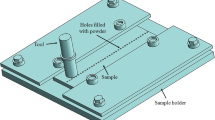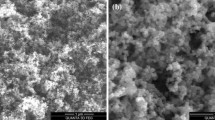Abstract
In this study, a AA7075-T6/ZrO2 nanocomposite was successfully fabricated. The effects of the traverse speed and the number of passes on mechanical properties were evaluated. For this purpose, after examining the external surfaces of the samples, various test samples were extracted. Metallographic samples were first investigated with a stereomicroscope and an optical microscope. Then for more details, such as observing grains with higher resolution and distribution of nanoparticles in the matrix, the samples were studied with an electron microscope. XRD and EDS analyses were also performed to evaluate the formed phases. For a more detailed study, metallographic samples were used for the microhardness test. Tensile tests were performed to assess nanocomposites’ yield and tensile strengths and to compare them with those of the base metal. Then, the fracture surfaces were examined under an electron microscope to observe and evaluate different aspects of fracture surfaces. Finally, an abrasion test was performed to assess the wear rate of nanocomposite samples and compare them with the base metal. Two main factors of grain and agglomeration sizes play important roles in the mechanical and wear properties. The Mean and max microhardness of the base metal was increased by 31.3% and 44% by nanocomposite production, respectively. Even though the tensile properties such as yield and tensile strength decreased compared to the base metal, they are better with a long-distance than annealed condition. Also, the wear rate in sample 30–1, which had minimum grain and agglomeration size, decreased up to 67% compared to the base metal.

















Similar content being viewed by others
Data availability
The raw data required to reproduce these findings cannot be shared at this time as the data also forms part of an ongoing study.
References
Sharifi Asl N, Mirsalehi SE, Dehghani K (2019) Effect of TiO2 nanoparticles addition on microstructure and mechanical properties of dissimilar friction stir welded AA6063-T4 aluminum alloy and AZ31B-O magnesium alloy. J Manuf Process 38(November 2018):338–354. https://doi.org/10.1016/j.jmapro.2019.01.023
Hejazi I, Mirsalehi SE (2016) Effect of pin penetration depth on double-sided friction stir welded joints of AA6061-T913 alloy. Trans Nonferrous Met Soc China (English Ed. 26(3):676–683. https://doi.org/10.1016/S1003-6326(16)64158-4
Kashaev N, Ventzke V, Çam G (2018) Prospects of laser beam welding and friction stir welding processes for aluminum airframe structural applications. J Manuf Process 36:571–600
Çam G, İpekoğlu G, Tarık Serindağ H (2014) Effects of use of higher strength interlayer and external cooling on properties of friction stir welded AA6061-T6 joints. Sci. Technol. Weld. Join. 19(8):715–720
Madhu HC, Edachery V, Lijesh KP, Perugu CS, Kailas SV (2020) Fabrication of wear-resistant Ti3AlC2/Al3Ti hybrid aluminum composites by friction stir processing. Metall Mater Trans A Phys Metall Mater Sci 51(8):4086–4099. https://doi.org/10.1007/s11661-020-05821-1
Çam G, İpekoğlu G (2017) Recent developments in joining of aluminum alloys. Int J Adv Manuf Technol 91(5):1851–1866
Hou YF, Liu CY, Zhang B, Wei LL, Dai HT, Ma ZY (2019) Mechanical properties and corrosion resistance of the fine grain structure of Al–Zn–Mg–Sc alloys fabricated by friction stir processing and post-heat treatment. Mater Sci Eng A 785(December):2020. https://doi.org/10.1016/j.msea.2020.139393
İpekoğlu G, Çam G (2014) Effects of initial temper condition and postweld heat treatment on the properties of dissimilar friction-stir-welded joints between AA7075 and AA6061 aluminum alloys. Metall Mater Trans A 45(7):3074–3087
Moustafa EB, Mosleh AO (2020) Effect of (Ti–B) modifier elements and FSP on 5052 aluminum alloy. J Alloys Compd 823:153745. https://doi.org/10.1016/j.jallcom.2020.153745
Netto N, Zhao L, Soete J, Pyka G, Simar A (2020) Manufacturing high strength aluminum matrix composites by friction stir processing: an innovative approach. J Mater Process Technol 283(September 2019):116722. https://doi.org/10.1016/j.jmatprotec.2020.116722
Rana HG, Badheka VJ, Kumar A (2016) Fabrication of Al7075 / B4C surface composite by novel friction stir processing (FSP) and investigation on wear properties. Procedia Technol 23:519–528. https://doi.org/10.1016/j.protcy.2016.03.058
Mishra M, Prakash C, Shabadi R, and Singh S (2020) Mechanical and microstructural characterization of magnesium/multi-walled carbon nanotubes composites fabricated via friction stir processing, in Advances in Materials Science and Engineering, Springer, 137–147
Balakrishnan M, Dinaharan I, Kalaiselvan K, Palanivel R (2020) Friction stir processing of Al3Ni intermetallic particulate reinforced cast aluminum matrix composites: microstructure and tensile properties. J Mater Res Technol 9(3):4356–4367. https://doi.org/10.1016/j.jmrt.2020.02.060
Jamali A, Mirsalehi SE (2022) Production of AA7075/ZrO2 nanocomposite using friction stir processing: metallurgical structure, mechanical properties and wear behavior. CIRP J Manuf Sci Technol 37:55–69
Khodabakhshi F, Arab SM, Švec P, Gerlich AP (2017) Fabrication of a new Al-Mg/graphene nanocomposite by multi-pass friction-stir processing: dispersion, microstructure, stability, and strengthening. Mater Charact 132:92–107. https://doi.org/10.1016/j.matchar.2017.08.009
Mahajan S, Sharma L, Rayat MS, Singh R (2020) Evaluation of mechanical properties of carbon fiber-reinforced multiwall carbon nanotube-based nanocomposites, in Advances in Materials Science and Engineering, Springer, 31–48
Abbass MK and Baheer NA (2020) Effect of SiC particles on microstructure and wear behavior of AA6061-T6 aluminum alloy surface composite fabricated by friction stir processing, IOP Conf Ser Mater Sci Eng, 671(1), https://doi.org/10.1088/1757-899X/671/1/012159
Moustafa EB, Melaibari A, Basha M (2020) Wear and microhardness behaviors of AA7075/SiC-BN hybrid nanocomposite surfaces fabricated by friction stir processing. Ceram Int 46(10):16938–16943. https://doi.org/10.1016/j.ceramint.2020.03.274
Sibisi TH et al (2020) Effect of processing parameters on corrosion behaviour of Al reinforced with Ni-40Fe-10Ti alloy fabricated by FSP. Int J Adv Manuf Technol 110(9–10):2703–2711. https://doi.org/10.1007/s00170-020-06031-0
Çam G, Javaheri V, Heidarzadeh A (2022) Advances in FSW and FSSW of dissimilar Al-alloy plates. J Adhes Sci Technol 1–33
Bagheri B, Abbasi M, Abdollahzadeh A, Mirsalehi SE (2020) Effect of second-phase particle size and presence of vibration on AZ91/SiC surface composite layer produced by FSP. Trans Nonferrous Met Soc China (English Ed 30(4):905–916. https://doi.org/10.1016/S1003-6326(20)65264-5
Küçükömeroğlu T, Aktarer SM, İpekoğlu G, Çam G (2018) Mechanical properties of friction stir welded St 37 and St 44 steel joints. Mater Test 60(12):1163–1170
Emamikhah A, Jamali A, Kazerooni A, Soleimanloo AM (2021) Friction stir welding of CuZn40 brass alloy based on optimal response surface results: numerical and experimental analyses. Adv J Sci Eng 2(1):3–17
Çam G (2011) Friction stir welded structural materials: beyond Al-alloys. Int Mater Rev 56(1):1–48
Küçükömeroğlu T, Aktarer SM, İpekoğlu G, ÇAM G (2018) Effect of multi-pass friction stir processing on the microstructure and mechanical properties of dual phase steel. pp 158–163
Rana H, Badheka V (2019) Elucidation of the role of rotation speed and stirring direction on AA 7075-B 4 C surface composites formulated by friction stir processing. Proc Inst Mech Eng Part L J Mater Des Appl 233(5):977–994. https://doi.org/10.1177/1464420717736548
Rahmatian B, Dehghani K, Mirsalehi SE (2020) Effect of adding SiC nanoparticles to nugget zone of thick AA5083 aluminium alloy joined by using double-sided friction stir welding. J Manuf Process 52(October 2019):152–164. https://doi.org/10.1016/j.jmapro.2020.01.046
Çam G, Ventzke V, Dos Santos JF, Koçak M, Jennequin G, Gonthier-Maurin P (1999) Characterisation of electron beam welded aluminium alloys. Sci Technol Weld Join 4(5):317–323
Khodabakhshi F, Simchi A, Kokabi AH (2017) Surface modifications of an aluminum-magnesium alloy through reactive stir friction processing with titanium oxide nanoparticles for enhanced sliding wear resistance. Surf Coatings Technol 309:114–123. https://doi.org/10.1016/j.surfcoat.2016.11.060
Khodabakhshi F, Simchi A, Kokabi AH, Sadeghahmadi M, Gerlich AP (2015) Reactive friction stir processing of AA 5052 – TiO 2 nanocomposite : process – microstructure – mechanical characteristics. Mater Sci Technol 31(4):426–435. https://doi.org/10.1179/1743284714Y.0000000573
ASTM Standard E8/E8M-13a (2013) Standard Test Methods for Tension Testing of Metallic Materials. ASTM Int. pp 1–27
ASTM International (2017) ASTM G99-17, Standard Test Method for Wear Testing with a Pin-on-Disk Apparatus. Annual Book of ASTM Standards, vol. 05, no. 2016. ASTM International West Conshohocken, pp 1–6
İpekoğlu G, Çam G (2019) Formation of weld defects in cold metal transfer arc welded 7075–T6 plates and its effect on joint performance. IOP Conference Series: Materials Science and Engineering 629(1):12007
Çam G, Koçak M (2007) Microstructural and mechanical characterization of electron beam welded Al-alloy 7020. J Mater Sci 42(17):7154–7161
Barmouz M, Asadi P, BesharatiGivi MK, Taherishargh M (2011) Investigation of mechanical properties of Cu/SiC composite fabricated by FSP: effect of SiC particles’ size and volume fraction. Mater Sci Eng A 528(3):1740–1749. https://doi.org/10.1016/j.msea.2010.11.006
Khodabakhshi F, Simchi A, Kokabi AH, Gerlich AP (2015) Friction stir processing of an aluminum-magnesium alloy with pre-placing elemental titanium powder: in-situ formation of an Al3Ti-reinforced nanocomposite and materials characterization. Mater Charact 108:102–114
Porter DA, Easterling KE, Easterling KE (2009) Phase transformations in metals and alloys (Revised reprint). CRC press
Eskandari H, Taheri R, Khodabakhshi F (2016) Friction-stir processing of an AA8026-TiB2-Al2O3 hybrid nanocomposite: microstructural developments and mechanical properties. Mater Sci Eng A 660:84–96. https://doi.org/10.1016/j.msea.2016.02.081
Khodabakhshi F, Gerlich AP, Švec P (2017) Fabrication of a high strength ultra-fine grained Al-Mg-SiC nanocomposite by multi-step friction-stir processing. Mater Sci Eng A 698:313–325. https://doi.org/10.1016/j.msea.2017.05.065
Totten GE, Mackenzie DS (2003) Handbook of aluminum volumen 7: physical metallurgy and porcesses. Phys Creep p 1309
Davis JR (1993) ASM specialty handbook. ASM International Materials Park, OH
Khodabakhshi F, Simchi A, Kokabi AH, Nosko M, Simanĉik F, Švec P (2014) Microstructure and texture development during friction stir processing of Al-Mg alloy sheets with TiO2 nanoparticles. Mater Sci Eng A 605:108–118. https://doi.org/10.1016/j.msea.2014.03.008
Khodabakhshi F, Gerlich AP, Simchi A, Kokabi AH (2015) Cryogenic friction-stir processing of ultrafine-grained Al-Mg-TiO2 nanocomposites. Mater Sci Eng A 620:471–482. https://doi.org/10.1016/j.msea.2014.10.048
Rathee S, Maheshwari S, and Siddiquee AN (2017) Issues and strategies in composite fabrication via friction stir processing : a review, Mater Manuf Process, 6914(March, 2017), https://doi.org/10.1080/10426914.2017.1303162
Roy P, Singh S, Pal K (2017) Enhancement of mechanical and tribological properties of SiC- and CB-reinforced aluminium 7075 hybrid composites through friction stir processing. Adv Compos Mater 28(sup1):1–18. https://doi.org/10.1080/09243046.2017.1405596
Author information
Authors and Affiliations
Corresponding author
Ethics declarations
Conflict of interest
The authors declare no competing interests.
Additional information
Publisher's note
Springer Nature remains neutral with regard to jurisdictional claims in published maps and institutional affiliations.
Recommended for publication by Commission I – Additive Manufacturing, Surfacing, and Thermal Cutting
Rights and permissions
About this article
Cite this article
Jamali, A., Mirsalehi, S.E. Investigation on effects of traverse speed and number of passes on mechanical and abrasive properties of AA7075-T6/ZrO2 surface nanocomposite produced using friction stir processing. Weld World 66, 2297–2313 (2022). https://doi.org/10.1007/s40194-022-01331-3
Received:
Accepted:
Published:
Issue Date:
DOI: https://doi.org/10.1007/s40194-022-01331-3




